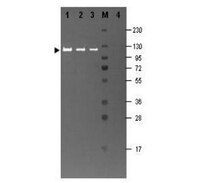Vimentin-dependent spatial translocation of an activated MAP kinase in injured nerve.
Perlson, Eran, et al.
Neuron, 45: 715-26 (2005)
2005
Show Abstract
How are phosphorylated kinases transported over long intracellular distances, such as in the case of axon to cell body signaling after nerve injury? Here, we show that the MAP kinases Erk1 and Erk2 are phosphorylated in sciatic nerve axoplasm upon nerve injury, concomitantly with the production of soluble forms of the intermediate filament vimentin by local translation and calpain cleavage in axoplasm. Vimentin binds phosphorylated Erks (pErk), thus linking pErk to the dynein retrograde motor via direct binding of vimentin to importin beta. Injury-induced Elk1 activation and neuronal regeneration are inhibited or delayed in dorsal root ganglion neurons from vimentin null mice, and in rats treated with a MEK inhibitor or with a peptide that prevents pErk-vimentin binding. Thus, soluble vimentin enables spatial translocation of pErk by importins and dynein in lesioned nerve. | 15748847
 |








